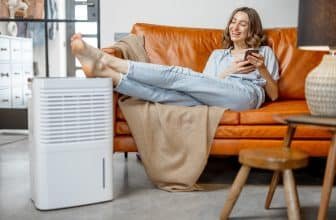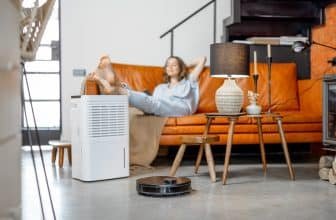Ozone Air Purifiers: Evaluating Areas of Application and Limitations
Ozone air purifiers are commonly used to improve indoor air quality by eliminating odors, mold, bacteria, and other pollutants. However, there are certain limitations and challenges associated with the use of ozone air purifiers that must be considered. Therefore, it is important to evaluate the best areas of application for ozone air purifiers and situations in which they are less suitable.

Ozone air purifiers work by generating ozone gas, which reacts with and eliminates pollutants in the air. However, excessive exposure to ozone gas can lead to respiratory problems and other health issues. Therefore, it is important to follow health considerations and safety guidelines when using ozone air purifiers. Additionally, ozone air purifiers are not effective in removing particulate matter such as dust and pet dander, which can be better removed by other air cleaning technologies such as HEPA filters.
Key Takeaways
- Ozone air purifiers are effective in eliminating odors, mold, bacteria, and other pollutants from indoor air.
- Ozone air purifiers should be used with caution due to potential health risks associated with excessive exposure to ozone gas.
- Ozone air purifiers are not effective in removing particulate matter such as dust and pet dander, which can be better removed by other air cleaning technologies such as HEPA filters.
Principles of Ozone Air Purification
Ozone air purifiers are devices that use ozone gas to disinfect the air by oxidizing and breaking down organic and inorganic pollutants. The process of ozone air purification is based on the chemical properties of ozone and its ability to react with and oxidize a wide range of organic and inorganic compounds.
Chemical Properties of Ozone
Ozone (O3) is a highly reactive gas with a distinctive odor that consists of three oxygen atoms. It is an unstable molecule that readily decomposes into oxygen (O2) and a free oxygen atom. The free oxygen atom can then react with other molecules to form oxidation products, such as hydroxyl radicals (OH), which are highly reactive and can oxidize a wide range of organic and inorganic compounds.
Ozone Generation Methods
Ozone generators are devices that produce ozone gas by one of several methods. The most common method is corona discharge, in which a high voltage is applied to a dielectric material, such as glass or ceramic, to create a corona discharge. The corona discharge ionizes oxygen molecules in the air, which then react with other oxygen molecules to form ozone.
Mechanisms of Air Disinfection
Ozone air purifiers disinfect the air by oxidizing and breaking down organic and inorganic pollutants. When ozone gas comes into contact with a pollutant, such as a virus, bacteria, mold, or volatile organic compound (VOC), it reacts with the pollutant and breaks it down into simpler, less harmful compounds. The oxidation products of ozone are typically carbon dioxide, water, and other harmless compounds.
However, it is important to note that ozone air purifiers have limitations and are not suitable for all applications. Prolonged exposure to high levels of ozone can be harmful to human health, and ozone can also react with some materials, such as rubber, plastics, and fabrics, causing them to deteriorate over time. Therefore, ozone air purifiers should be used only in well-ventilated areas and for short periods of time.
Evaluating Indoor Air Quality

Indoor air quality (IAQ) refers to the quality of air inside buildings and structures, as it relates to the health and comfort of occupants. Poor IAQ can lead to a range of health problems, including headaches, fatigue, irritation of the eyes, nose, and throat, respiratory diseases, and more. Therefore, it is crucial to evaluate IAQ regularly to ensure a healthy and comfortable living environment.
Common Indoor Air Pollutants
There are several common indoor air pollutants that can affect IAQ. These include:
- Volatile Organic Compounds (VOCs): These are chemicals released by many household products, including paints, varnishes, cleaning supplies, and more.
- Nitrogen Oxides (NOx): These are a group of gases that can be released by gas stoves, furnaces, and other combustion sources.
- Particulate Matter (PM): These are tiny particles that can be released by a range of sources, including smoking, cooking, and more.
Impact of Ozone on Air Quality
Ozone air purifiers have become increasingly popular in recent years as a means of improving IAQ. However, it is important to note that ozone can also be an air pollutant. While ozone can help to eliminate some indoor air pollutants, it can also react with other chemicals in the air to produce harmful byproducts.
Therefore, it is important to use ozone air purifiers in a well-ventilated area and only for short periods of time. Ozone air purifiers are best suited for areas with high levels of smoke, mold, or other strong odors. However, they are less suitable for areas with high levels of VOCs or NOx, as the ozone can react with these chemicals to produce harmful byproducts.
Effective Applications of Ozone Purifiers
Ozone air purifiers are effective in eliminating odors, disinfecting surfaces, and cleaning indoor air. They are commonly used in residential, commercial, healthcare, and industrial settings. In this section, we will explore the best areas of application for ozone air purifiers and situations in which they are less suitable.
Residential Use
Ozone air purifiers are suitable for residential use in homes with strong odors, mold, or mildew. They are effective in removing pet odors, cigarette smoke, and cooking smells. Ozone air purifiers can also be used to disinfect surfaces and clean indoor air. However, ozone air purifiers can be harmful to humans and pets if used improperly. Therefore, it is important to follow the manufacturer’s instructions and use ozone air purifiers in an unoccupied room.
Commercial and Healthcare Settings
Ozone air purifiers are effective in commercial and healthcare settings where disinfection is critical. They are commonly used in hospitals, clinics, and dental offices to disinfect surfaces and clean indoor air. Ozone air purifiers can also be used in gyms, spas, and hotels to eliminate odors and disinfect surfaces. However, ozone air purifiers should not be used in areas where people are present as ozone can cause respiratory problems.
Industrial Applications
Ozone air purifiers are effective in industrial settings where water treatment and decontamination are critical. They are commonly used in water treatment plants, food processing plants, and pharmaceutical factories to disinfect surfaces and clean indoor air. Ozone air purifiers can also be used in ventilation systems to eliminate odors and disinfect surfaces. However, ozone air purifiers should not be used in areas where people are present as ozone can cause respiratory problems.
In conclusion, ozone air purifiers are effective in eliminating odors, disinfecting surfaces, and cleaning indoor air. They are commonly used in residential, commercial, healthcare, and industrial settings. However, ozone air purifiers should not be used in areas where people are present as ozone can cause respiratory problems. Therefore, it is important to follow the manufacturer’s instructions and use ozone air purifiers in an unoccupied room.
Health Considerations and Safety Guidelines

Exposure Risks and Health Effects
Ozone air purifiers have the potential to cause adverse health effects. Exposure to high levels of ozone can cause lung damage, respiratory system irritation, and other health risks. According to the Environmental Protection Agency (EPA), exposure to ozone concentrations above 0.1 ppm can cause adverse health effects.
Furthermore, long-term exposure to elevated levels of ozone is associated with premature mortality. The California Air Resources Board (CARB) has set an 8-hour average standard of 70 ppb for ozone to protect public health.
It is important to note that ozone air purifiers are not recommended for use in occupied spaces. High concentrations of ozone in the air can be harmful to people and pets, especially those with respiratory issues. Therefore, it is recommended to use ozone air purifiers in unoccupied spaces, such as hotel rooms, apartments, and cars.
Regulatory Standards and Recommendations
The EPA and CARB have established regulatory standards and recommendations for ozone air purifiers. The EPA has issued a warning against the use of ozone air purifiers, stating that they can cause adverse health effects. The CARB has also issued a warning against the use of ozone air purifiers, stating that they can produce indoor ozone levels several times higher than the outdoor health standards.
To ensure the safety of ozone air purifiers, it is important to follow safety guidelines and recommendations. The EPA recommends that ozone air purifiers should not be used in occupied spaces and that the ozone concentration should not exceed 0.1 ppm. The CARB recommends that ozone air purifiers should not be used in indoor spaces and that the ozone concentration should not exceed 0.05 ppm.
In summary, ozone air purifiers have the potential to cause adverse health effects, and it is important to follow safety guidelines and recommendations to ensure their safe use. It is recommended to use ozone air purifiers in unoccupied spaces and to avoid exposure to high ozone concentrations.
Limitations and Challenges

Ineffectiveness on Certain Pollutants
Ozone air purifiers are not effective in removing all types of pollutants. For example, they are not effective in removing particles such as dust, pet dander, or pollen. These pollutants are often too large for ozone to react with and eliminate. Additionally, ozone air purifiers are not effective against volatile organic compounds (VOCs) and other gaseous pollutants. Thus, ozone air purifiers are not suitable for people with allergies or respiratory issues caused by these types of pollutants.
Ozone Emissions and Byproducts
One of the biggest limitations of ozone air purifiers is the potential for ozone emissions and byproducts. Ozone is a reactive molecule that can react with other chemicals in the air to form byproducts such as formaldehyde and ultrafine particles. These byproducts can be harmful to human health, especially for people with respiratory issues. Furthermore, ozone air purifiers can produce high levels of ozone, which can be harmful to human health. According to IQAir, ozone air purifiers that produce more than 0.05 parts per million (ppm) of ozone can cause respiratory problems.
In addition, ozone air purifiers can also damage surfaces and materials in the home, such as rubber, plastic, and fabrics. This is because ozone can break down the chemical bonds in these materials, causing them to deteriorate faster. Therefore, it is important to use ozone air purifiers in a well-ventilated area and to follow the manufacturer’s instructions carefully.
Overall, ozone air purifiers have limitations and challenges that should be considered before purchasing them. They are not suitable for all types of pollutants and can produce harmful byproducts and emissions. Therefore, it is important to weigh the benefits and risks before deciding to use an ozone air purifier.
Comparative Analysis of Air Cleaning Technologies

When it comes to air cleaning technologies, there are several options available in the market. Each technology has its own strengths and limitations. Here, we will provide a comparative analysis of some of the most popular air cleaning technologies.
HEPA Filters and Activated Carbon
HEPA filters are one of the most common air cleaning technologies used in portable air cleaners. They are effective in removing particles as small as 0.3 microns in size. HEPA filters can remove a wide range of particles, including dust, pollen, mold spores, and pet dander.
Activated carbon filters are often used in conjunction with HEPA filters to remove odors and volatile organic compounds (VOCs). Activated carbon filters work by adsorbing gases and odors onto the filter media.
HEPA filters and activated carbon filters are both effective air cleaning technologies, but they have limitations. HEPA filters cannot remove gases and odors, and activated carbon filters have a limited lifespan.
Ionizers and Electrostatic Precipitators
Ionizers and electrostatic precipitators are air cleaning technologies that use an electric charge to remove particles from the air. Ionizers work by emitting negatively charged ions into the air, which attach to positively charged particles. The particles then become too heavy to remain airborne and fall to the ground.
Electrostatic precipitators work by charging particles as they pass through an electric field. The charged particles are then attracted to a collection plate with an opposite charge.
While ionizers and electrostatic precipitators can effectively remove particles from the air, they have limitations. Ionizers can produce ozone, which can be harmful to human health. Electrostatic precipitators can produce ozone and can also create a potential fire hazard if not properly maintained.
UV-Based Air Cleaners
UV-based air cleaners use ultraviolet light to kill bacteria and viruses in the air. These air cleaners work by exposing the air to UV-C light, which damages the DNA and RNA of microorganisms, preventing them from reproducing.
UV-based air cleaners are effective in killing bacteria and viruses, but they have limitations. They cannot remove particles from the air, and they require a certain amount of UV-C exposure time to be effective.
In summary, each air cleaning technology has its own strengths and limitations. HEPA filters and activated carbon filters are effective in removing particles and odors, but have limitations. Ionizers and electrostatic precipitators can effectively remove particles, but can produce ozone and create a potential fire hazard. UV-based air cleaners are effective in killing bacteria and viruses, but cannot remove particles from the air.
Optimizing Ozone Air Purifier Performance

Ozone air purifiers can be an effective tool for improving indoor air quality, but it is important to use them correctly to achieve the best results. Here are some strategies for effective use and maintenance considerations to optimize the performance of ozone air purifiers.
Strategies for Effective Use
To maximize the effectiveness of ozone air purifiers, it is important to use them in the right circumstances. Ozone air purifiers are most effective in situations where there are strong odors or volatile organic compounds (VOCs) present in the air. They can also be effective in reducing the presence of mold, mildew, and bacteria.
It is important to note that ozone air purifiers should not be used in occupied spaces. Ozone can be harmful to humans and pets when inhaled in high concentrations. Therefore, it is recommended to use ozone air purifiers in unoccupied spaces, such as basements or garages, or to use them in conjunction with a ventilation system that brings in outdoor air.
To achieve the best results, it is also important to ensure that the ozone output of the air purifier is appropriate for the size of the space being treated. Most ozone air purifiers come with guidelines for the appropriate ozone output for different room sizes.
Maintenance and Operational Considerations
To maintain the effectiveness of ozone air purifiers, it is important to follow proper maintenance and operational procedures. This includes regularly cleaning the air purifier’s filters and ensuring that the ozone output is set correctly.
It is also important to ensure that the space being treated is well-ventilated. Ozone air purifiers work by generating ozone, which can react with other compounds in the air to produce new compounds, some of which may be harmful. Therefore, it is important to ensure that there is adequate outdoor air ventilation to prevent the buildup of these compounds.
In addition, it may be helpful to use an exhaust fan in the space being treated to help remove any undesirable compounds that are generated during the ozone air purifier’s operation.
Finally, it is important to note that ozone air purifiers are not a replacement for in-duct air cleaners or other air cleaning technologies. They are most effective when used in conjunction with other air cleaning technologies to achieve comprehensive air cleaning.
Case Studies and Real-World Applications

Ozone air purifiers have been used in a variety of settings, from residential homes to commercial buildings. Here are a few examples of successful implementation of ozone air purifiers in real-world applications:
Residential Success Stories
In residential settings, ozone air purifiers have been used to eliminate odors from pets, cooking, and smoking. Ozone air purifiers have also been used to eliminate mold and mildew from damp areas such as basements and bathrooms. Some homeowners have reported significant improvements in indoor air quality after installing ozone air purifiers. However, it is important to note that ozone air purifiers are not suitable for use in occupied spaces, and should only be used when the area is unoccupied.
Commercial Implementation Examples
Ozone air purifiers have been used in a variety of commercial settings, including hotels, hospitals, and schools. In hotels, ozone air purifiers have been used to eliminate odors from smoking and cooking, as well as to sanitize rooms between guests. In hospitals, ozone air purifiers have been used to eliminate airborne pathogens and reduce the spread of infections. In schools, ozone air purifiers have been used to improve indoor air quality and reduce the spread of illnesses. However, it is important to note that ozone air purifiers can have negative impacts on the environment and should be used with caution.
Overall, ozone air purifiers can be effective in certain situations, but they are not suitable for all applications. It is important to consider the opportunities and limitations of ozone air purifiers before implementing them in any setting. Additionally, it is important to consider the environmental impacts and policy effectiveness of ozone air purifiers, as well as the source-receptor relationship between ozone air purifiers and indoor air quality.
Future Prospects and Technological Advances

Innovations in Ozone Generation
The ozone air purifier industry is rapidly evolving, and technological advances in ozone generation are expected to drive innovation in the future. One such innovation is the use of cold plasma technology to generate ozone. Cold plasma technology is a promising alternative to traditional corona discharge ozone generators, as it eliminates the need for high voltage and results in a more energy-efficient and eco-friendly process.
Another promising innovation is the use of ultraviolet (UV) light to generate ozone. UV ozone generators are smaller, more portable, and produce less ozone than traditional corona discharge generators. They are also more energy-efficient and require less maintenance. However, UV ozone generators are less effective in high humidity environments, limiting their applicability in certain situations.
Emerging Market Trends
The market for ozone air purifiers is expected to grow significantly in the coming years, driven by increasing concerns about indoor air quality and the health benefits of clean air. One emerging trend is the use of ozone air purifiers in commercial and industrial settings, such as hospitals, hotels, and manufacturing facilities. These applications require larger and more powerful ozone generators to effectively purify large spaces.
Another emerging trend is the integration of ozone air purifiers with other air purification technologies, such as HEPA filters and activated carbon filters. This combination approach can provide more comprehensive air purification and address a wider range of indoor air pollutants.
In conclusion, the future of ozone air purifiers looks promising, with technological advances and emerging market trends driving innovation and growth in the industry. While there are limitations to the use of ozone air purifiers, such as the potential health risks associated with high ozone concentrations, the benefits of clean air cannot be ignored. As the industry continues to evolve, we can expect to see more innovative solutions for indoor air purification.
Frequently Asked Questions
What are the optimal conditions for using an ozone air purifier in residential settings?
Ozone air purifiers are most effective when used in a closed, unoccupied room. This allows the ozone to circulate and eliminate any odors, bacteria, or viruses present in the air. It is important to follow the manufacturer’s instructions carefully and to use the ozone air purifier only for the recommended amount of time.
In which scenarios is the use of an ozone air purifier not recommended?
Ozone air purifiers should not be used in occupied rooms or in the presence of people or pets, as ozone can be harmful when inhaled in high concentrations. It is also not recommended to use ozone air purifiers for extended periods of time, as this can damage the respiratory system.
Can ozone air purifiers be safely used in vehicles, and if so, under what conditions?
Ozone air purifiers can be safely used in vehicles, but only when the vehicle is unoccupied. It is important to follow the manufacturer’s instructions carefully and to use the ozone air purifier only for the recommended amount of time.
What are the potential health risks associated with the use of ozone air purifiers?
Exposure to high levels of ozone can cause respiratory problems, including coughing, shortness of breath, and chest pain. Prolonged exposure can also damage the respiratory system and increase the risk of respiratory infections. It is important to use ozone air purifiers only in unoccupied areas and to follow the manufacturer’s instructions carefully to avoid exposure to high levels of ozone.
How does an ozone air purifier differ from traditional air purifiers, and what are its unique benefits?
Unlike traditional air purifiers, which use filters to trap pollutants, ozone air purifiers release ozone into the air to eliminate odors, bacteria, and viruses. Ozone air purifiers are effective at eliminating strong odors and can be used in unoccupied areas to quickly freshen the air.
What precautions should be taken when operating an ozone generator to mitigate exposure risks?
When operating an ozone generator, it is important to follow the manufacturer’s instructions carefully and to use the generator only in unoccupied areas. It is also recommended to wear protective gear, such as gloves and a mask, to avoid exposure to high levels of ozone. Additionally, it is important to ventilate the area thoroughly after using an ozone generator to ensure that all traces of ozone have dissipated.






